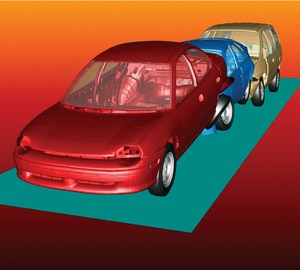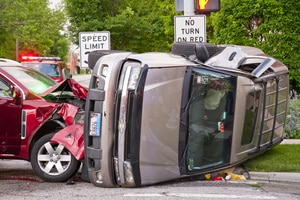Photogrammetry and Car Crashes
Among photogrammetry’s many useful applications is in the area of car crashes, specifically the reconstruction of car crashes after on-site evidence has been removed. The ability of photogrammetry to remake car accident scenes is tremendously important to the police and forensic specialists who investigate the aftermath of these kinds of events. This is because car crashes can result in significant bodily injury, property damage, and death. Sometimes, in these situations, the vehicle or vehicles involved in the crash are destroyed and cannot be accessed.
- Understanding Car Crash Physics
- How Does Photogrammetry Apply to Car Crash Scenes?
- Car Crash Photogrammetry Software
How can investigators piece an accident back together again? The answer is, in part, photogrammetry software, which can process photos of an accident scene, triangulate their points in 3D space, build 3D models of the area, and extract key measurements. Photogrammetric models can be used to recreate accident scenes to determine how fast a car was going when it crashed and the direction of travel. Law enforcement or other parties, in turn, can use these reconstructions as evidence in court.
In this post, we’re going to briefly touch on the physics of car crashes and then discuss how PhotoModeler Technologies’ photogrammetry program can help to reconstruct the scenes of these accidents for police and other forensic investigators.
Understanding Car Crash Physics

Reconstructing car accidents involves understanding the physics of how they happen. Boiled down to their essentials, car crashes involve a dangerous combination of force and energy. We’ll review some of the basic physics for the purpose of this educational resource. We consider three quantities when discussing collisions: force, momentum, and kinetic energy. When a car strikes an object, the momentum is always preserved. The forces acting on the objects depends on their mass and how they move (accelerate). Energy is never lost, but total kinetic energy can change (the remaining energy going to sound, heat, light, and material deformations). There is also the concept of elastic and inelastic collisions but for the car crash situation, it is a combination of both (this affects how momentum is transferred between objects). A car can hit an immovable object like a building, a movable object, like another car or a bike, or something in between, like a telephone post. In each case, the two objects act differently after the collision. The important post-collision characteristics here being the speeds and amounts of deformation after the collision.
We know from personal observation (and from many car crashes in the movies!), that a car hitting a big building might do a small amount of damage to the building (a crack or small dent), but the car will convert a lot of the kinetic energy into other energy such as noise and deformation. The large mass of the building (and the earth it is attached too) will mean it does not noticeably move. At the other end of the scale, a car hitting a bicycle or pedestrian, won’t have much damage itself but will impart a lot of energy (and damage) to the other object.
If you know the characteristics (mass, friction, etc.) of both objects (one is a car, and the other is a car, building, pole, bike, or person) you can determine things such as the speed at impact. If you know the speed, you can determine if the driver was illegally over the speed limit (and hence at fault). You can also determine directions of travel to confirm bystanders or driver accounts. This information helps determine fault for insurance claims and court cases. It is good for a case when the individuals’ verbal accounts agree with the physics!
How Does Photogrammetry Apply to Car Crash Scenes?
Photogrammetry software is important in car crashes because, sometimes, the measurement and models produced by photogrammetric means are the best or only evidence for later litigation in court. Those who work in photogrammetry, or who are long-time readers of the PhotoModeler Technologies blog, already know that photogrammetry takes measurements from photos – but exactly what is needed to prove causation in a car accident reconstruction?
For this, the photogrammetry algorithms of a program such as PhotoModeler need the photos to capture situational elements such as the angle of the crash, possible skid marks on the road, any and all property damage, the angles at which that property was struck, and, of course, the amount of crush damage in the vehicles themselves.
Overall, photogrammetry gives users the measurements of key aspects of the scene or cars from photos of those objects. From the measurements, investigators use other software or spreadsheets to compute the physics of the situation. They can compute the speed of the vehicles by converting car crush measurements into delta-v (change in velocity) or by measuring skid and yaw marks to estimate speed, or to map the scene and all its parts (the road, traffic signals, and light, the marks left by the cars, where the cars ended up, etc.). The photogrammetric map is useful evidence in court.
It is also worth mentioning that photos taken for the express purpose of photogrammetry should be taken by someone well-versed in photogrammetry itself. One must know the best camera positions and angles to use, and the correct “targets” to photograph for the photogrammetry software.
The application of measuring an accident scene by the police is one key application. They would use both photographs at ground level as well as photographs from drones. There is the ability to use photographs taken by non-experts as well – such as photographs taken by bystanders, insurance adjusters, or even by security cameras. These secondary photographs, combined with other scene data, can often produce key pieces of evidence for some cases.
Another salient point must be considered here: the difference between police and forensic investigators following a car crash. The two have distinct jobs. Police document evidence and make sure none of it gets destroyed. Once this is done, police must open up roads again to the public. Meanwhile, forensic investigators must be able to reconstruct the scene of the crash after the fact, and sometimes with less than perfect data (such as the bystander or security camera images mentioned above). The police can be involved with this accident scene reconstruction if the crash constituted a violent crime, and especially if there are fatalities.

In the end, however, by ensuring they acquire sufficient overlapping photos of all the relevant parts of the scene, investigators allow photogrammetric programs to point-match and triangulate the points in the photos and produce a scaled 2D or 3D model of the accident location. With all the model’s objects in their correct places and the angles geometrically correct, the forensic investigators can simply sit down at a computer and view the scene of a car crash from any angle they choose. This data is used to prove cause and to present cases in court.
Car Crash Photogrammetry Software
The incredible usefulness of photogrammetry software in car accident reconstruction is what makes our PhotoModeler product so useful to police, crime scene investigators, and engineers. PhotoModeler Technologies is proud of its longstanding relationship of 25 years with law enforcement and the engineering community, and we hope to continue that association indefinitely with our photogrammetry technology.
To learn more about the PhotoModeler software, contact our corporate office at sales@photomodeler.com.
